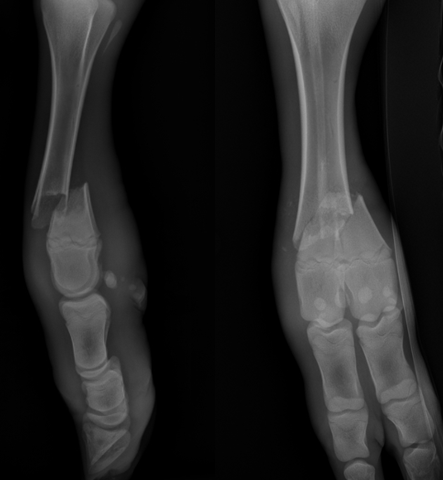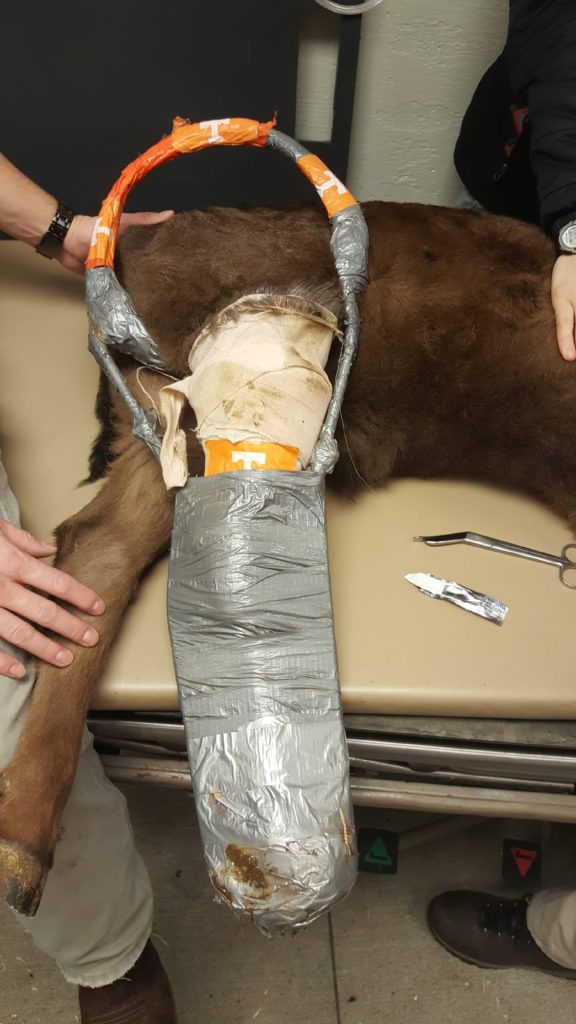

Dr. Lew Strickland
Associate Professor and Extension Livestock Veterinarian
Department of Animal Science
P: 865-974-3150
Co-author:
Pierre-Yves Mulon DVM DACVS
Assistant Professor Large Animal Clinical Sciences
The University of Tennessee College of Veterinary Medicine
Considering the environment that calves live in, limb fractures are rare. Typically, fractures result from external trauma to the limb. Causes of the fracture vary depending on age. Even before delivery, calves are subject to fractures due to dystocia (backward presentation, or an oversized calf). Newborn calves may suffer from being stepped on by a cow, and as they grow larger, fractures can occur from either self or mate-inflicted trauma.
The prognosis for fractures in calves is generally favorable. However, recovery depends on the bone affected, the location of the fracture within the bone shaft and even more importantly, whether or not there is an open wound close to the fracture.
Factors that favor a positive outcome
Early recognition of the fracture is extremely important. Recognition of fracture is easy when the leg is obviously dangling. However, a fracture through the growth plate may be more difficult to identify as they remain fairly stable and can externally present only with a slight deviation of the leg. Providing adequate first aid will limit further damages to the surrounding tissues (muscles, vessels nerves, and skin). A thick firm bandage associated with rigid splinting is the best option to protect the fracture site from secondary injury. The splint should be rigid enough to hold the weight of the animal, and extend from the hoof to as high as possible. Once wrapped with a bandage, the forelimbs are best protected by two wooden boards, with one on the outside (lateral) side of the leg from hoof to the shoulder and the second on the backside of the leg from the hoof to the elbow. The hind limbs are protected from the hoof to higher than the stifle with one solid wooden splint on the side of the leg. Temporary immobilization of the fracture should be done prior to moving the calf for further veterinary evaluation. In a newborn calf, semi-circular PVC pipes placed on the backside of the limb are sufficient to protect the fracture that has occurred just above the fetlock.
Confinement and separation of the animal from the herd should be implemented as soon as possible by moving the injured calf along with the dam (if still nursing) to a pen in a barn.
Outcome of specific fractures
Calving chain injuries
Fracture of the lower cannon bone just above the growth plate typically result from excessive traction and misplacement of the obstetrical chains. Generally, those fractures remain closed and carry an excellent prognosis for recovery. The typical treatment is placement of padding and a cast for 6-8 weeks; however, the cast needs to be changed after 3 weeks as the animal outgrows the external shell placed on the leg quickly. In rare occasions, the damage of the chain to the skin permanently impairs its blood supply, leading to the sloughing of the skin, which is the major complication that can be encountered.
Femoral fractures in newborn calves
These fractures typically occur during backward (breech) presentation calving, when the rotation of the calf is initiated prior to the calf’s hips entering birth canal. This specific configuration creates pressure on the shaft of the femur, which explains the consistent type of fracture described. The heavy muscle mass around the bone protects against the opening of the fracture, but muscle contractions quickly induce severe overriding of the bone fragments. The best repair for those fractures is surgical, with the use of orthopedic implants. Even if the stabilization remains somewhat expensive, the prognosis has been considered fair to good in two large number studies (Nichols, Bellon). This surgical repair is best suited for calves intended to enter the farm’s breeding program.
Fracture through the growth plate of the cannon bone
This type of fracture occurs mainly by self-inflicted traction/trauma on the limb to dislodge it from being trapped in an object such as a feeder. These fractures heal fast and are relatively stable if they remain closed. Recovery carries an excellent prognosis and usually require only an external stabilization by a cast for 6 to 8 weeks. Surprisingly, the length of the leg is not affected by the temporary disruption of the cartilaginous growth plate after the reduction and stabilization of the fracture.
Other type of fractures
All bones in the calf are subject to fracture. Different treatment options exist depending on the bone and the type of fracture (simple or complex). Performing two radiographs (X ray) obtain the best evaluation of the fracture prior to deciding which treatment is the most appropriate and aids the veterinarian in determining the prognosis for recovery.
As a rule of thumb, the higher the fracture is on the limb, the more difficult it is to immobilize. The slightest movement in the joints below and above the fracture prevent formation of healing tissue between the two bone fragments. Fracture of the radius (just above the carpus), or tibia (just above the hock) are best treated with either the addition of a metallic splint (Modified Thomas-Schroeder splint) to the full limb cast, or by using orthopedic pins in the bone in addition to the cast. More advanced surgical procedures such as plates and fixators are available and should be discussed with your veterinarian on a case-by-case basis.
On farm care for the immobilized calf
Daily care for a fractured limb is time consuming and should not be underestimated while considering the recovery period. Even a simple full limb cast requires specific attention. The animal should be confined until 4 weeks after final removal of the immobilization device and maintained in a dry and clean pen. The comfort, monitored by the amount of weight bearing on the cast, should be monitored daily for improvement over time. Any subtle reduction of the use of the immobilized limb is a sign of some pain, which is easily hidden by the presence of the cast. Therefore, veterinary re-assessment is important immediately as it can rapidly compromise the course of the healing.
If not dealt with in a timely manner, limbs fractures can be costly. However, if properly treated and managed, a fracture will heal and a calf can mature and become a productive addition to your herd. If you have any questions, please contact us through the Farm Animal clinical services https://vetmed.tennessee.edu/vmc/farmanimalhospital/
Figure 1: Radiographs of a newborn calf suffering of a calving chain injury fracture. The lower portion of the metarcarpal bone is completely broken. An obvious misalignment of the two bone segments is visible.

Figure 2: Full limb cast associated with an external metallic splint (Modified Thomas-Schroeder splint) applied on the hind limb of a calf suffering from a fracture of the tibia.

References
Nichols S, et al. Femoral diaphysis fractures in cattle: 26 cases (1994–2005). Aus Vet J. 2010;88:39-44.
Bellon J, Mulon PY. Use of a novel intramedullary nail for femoral fracture repair in calves: 25 cases (2008–2009). JAVMA. 2011;238:1-7.
